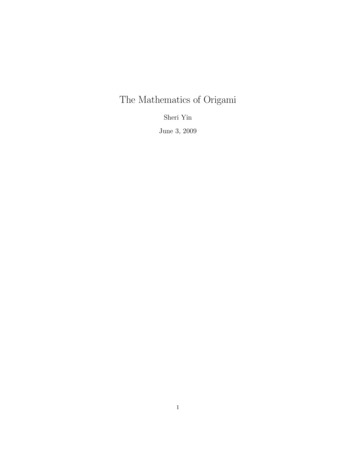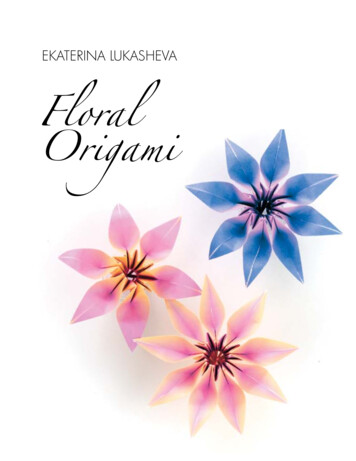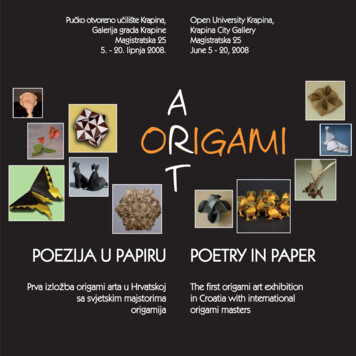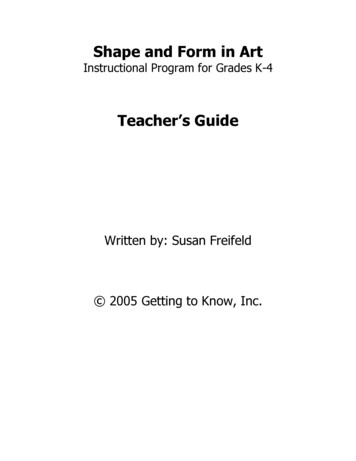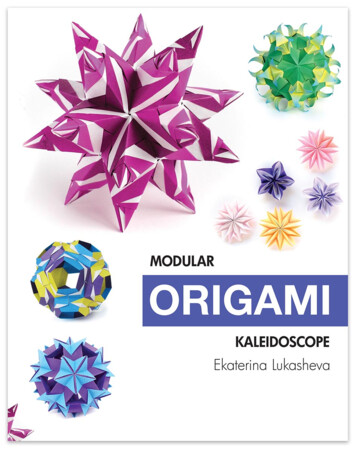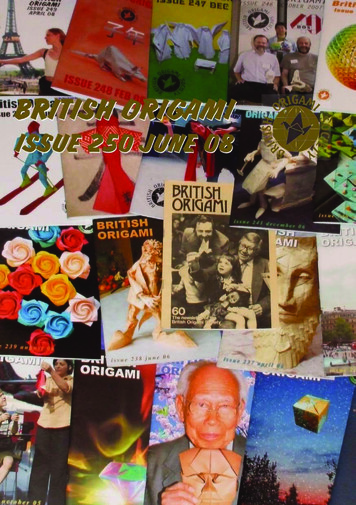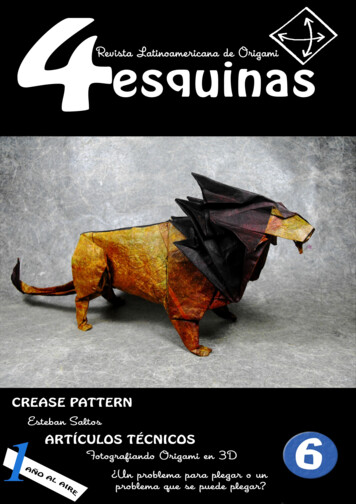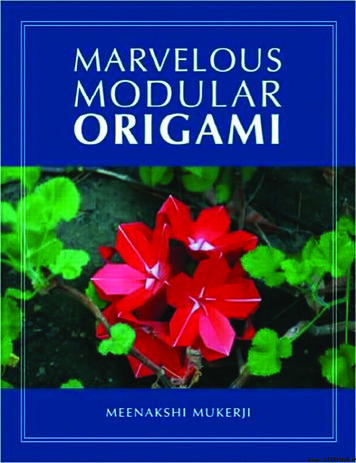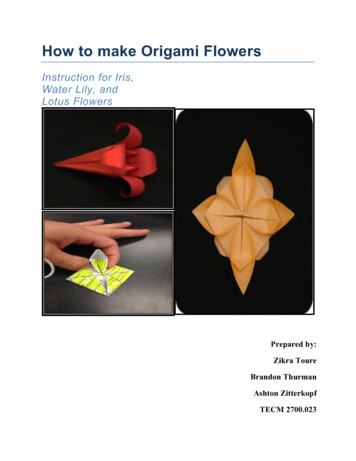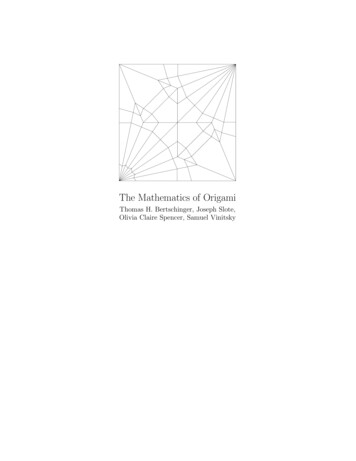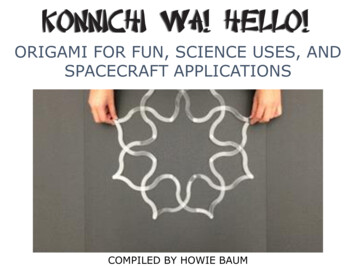
Transcription
ORIGAMI FOR FUN, SCIENCE USES, ANDSPACECRAFT APPLICATIONSCOMPILED BY HOWIE BAUM
ORIGAMI Origami, (pronounced or-i-GA-me) is the Japanese art of paperfolding. "Ori" is the Japanese word for folding and "kami" is theJapanese word for paper.
The Origins of Origami. . .Although Origami is knownas a Japanese Art, itactually began in China.The Chinese inventedpaper around 100 A.D.,and when the inventionspread to Japan around600 A.D., so did the art ofpaper folding.
FIRST BOOK ON ORIGAMIThe first known book on how to make an origami object waswritten in 1797 and is called The Secret of One ThousandCranes Origami (Hiden Senbazuru Orikata)Pictured to the left are pagesfrom “The Secret of OneThousand Cranes Origami”.
THE HISTORY OF ORIGAMI The art of paper folding was not called Origami until the end of thenineteenth century. By the 1950’s origami gained popularity from world famous origami artistAkira Yoshizawa (1911-2005). He created more than 50,000 models. He wrote 18 books about the art of origami. In 1983, he was named into the “Order of the Rising Sun”, one of thehighest honors that can be given to a Japanese citizen, by Japaneseemperor Hirohito.
BASES When you are making origami models, you will be doing the same set offolds in the beginning stage even though the final outcome is different. The sets of folds in the beginning stages are called origami bases. You canclick on each of these links to see how to make them. Kite BaseFish BaseWaterbomb BasePreliminary BaseWindmill BaseBird BaseFrog BaseCommon Origami BasesThe preliminary and waterbomb bases are thebread-and-butter of the origami world.There are many origami models which start withthese two bases. In fact, the two bases are interconvertible: if you invert the preliminary, it willbecome a waterbomb base. The opposite is also true,a waterbomb base can be inverted to form thepreliminary. The only issue being that the colors(color or white) would be inverted too.
EXAMPLES OFORIGAMI FOLDS
MAIN FOLDING LINES A crease is a line segment,or even a curve, on a pieceof paper. Creases may be folded inone of two ways: as amountain fold, forming aprotruding ridge, or a valleyfold, forming (not altogethersurprisingly) a valley. A crease pattern is acollection of creases. A mountain-valleyassignment is a specificationof which creases should befolded as mountains, andthe low parts becomevalleys.Origami SymbolsLines, Arrow & SymbolsORIGAMI BASICS FOLDSValley FoldMountain FoldPleat FoldBlintz FoldSquash FoldPetal FoldInside Reverse FoldOuside Reverse FoldSink FoldRabbit Ear FoldCrimp FoldNote: The blue,underlined items tothe left and on thenext page, are allactive links so if youwant to learn moreabout any of them,just click on them inpresentation mode.The info on this andthe next slide is froman excellent basics.html
Shapes of PaperMake a Square:from a RectangleMake a Triangle:from a Square (easy)from a Square (efficient)from a RectangleMake a Pentagon:from a square, A5Make a Hexagon:from a Squarefrom a RectangleMake a Heptagon:from a square (easy)from a square or circle (easy)from a circle (not easy)from a square (with proofs)from a square (exact?)Make an Octagon:from a SquareMake a A4, A5, or A6 Paper:from a Squarefrom 8.5" x 11"Make a Dollar Bill proportion:from 8.5" x 11"Make the Largest Square:from a Dollar Bill (S Chen)Dividing PaperDivide into Thirds:Method 1Method 2Method 3Estimation MethodMore Methods (diagrams by HKoshiro)Divide into Fifths:Method 1Method 2Method 3Fujimoto's ApproximationMethodDivide into Sevenths:Method 1Method 2Method 3Divide into Any number ofSegments:Intersecting Diagonals MethodUsing a TemplateUsing Scissors
GOLDEN RULES FOR PAPER FOLDING ORIGAMI Always work on a smooth flat surface. Make your folds carefully. Run your bone folder or thumbnail along the crease each timeyou make a fold to make it crisp. Begin by folding the basic shape required. The instruction steps should be followed in sequence. They won’t makesense if read alone.John Collins holds theGuinness World Record fordesigning the farthest flyingpaper airplane.The plane, folded from asingle piece of paper, Flew227 feet (76 yards), in2012.https://www.youtube.com/watch?time continue 2&v qmCTdCLxJRM
THE ANCIENT ART OF KIRIGAMI IS INSPIRINGA NEW CLASS OF MATERIALSOrigami-inspired materials use folds in materials to embed powerfulfunctionality. However, all that folding can be pretty labor intensive.Now, researchers at the Harvard John A. Paulson School of Engineering andApplied Sciences (SEAS) are drawing material inspiration from anotherancient Japanese paper craft—kirigami.It relies on cuts, rather than folds, to change the structure and function ofmaterials, by just stretching it.https://www.youtube.com/watch?time continue 9&v 1vG4OthRJUQ
Scraped up knees and elbows are tricky places to securely apply a bandage.More often than not, the adhesive will peel away from the skin with just afew bends of the affected joint.Now MIT engineers have come up with a stickier solution, in the form of athin, lightweight, rubber-like film. The adhesive film can stick to highlydeformable regions of the body and maintain its hold even after 100 bendingcycles.The key to the film's clinginess is a pattern of slits that the researchers havecut into the film, similar to the cuts made in a paper-folding art form knownas Kirigami.
THESE KIRIGAMI FORMED PAPER PUPPETS ARE A FUNUSE OF THE ART FORM
JAPAN - NEW DISCOVERIES IN PAPER FOLDINGhttps://www.youtube.com/watch?v Fz4Ioi1jFHY
BULLET-PROOF ORIGAMI:FOLDING KEVLAR SHIELD, USINGTHE YOSHIMURA BENDINGMETHODAn origami-inspired, lightweight bulletproofshield stopped bullets from 9 mm, .357Magnum and .44 Magnum pistols.It is made of 12 layers of bulletproof Kevlarand weighs only 55 pounds (many of thesteel-based barriers in current useapproach 100 pounds).It uses a Yoshimura origami creasepattern to expand around an officer,providing protection on the side inaddition to protecting them in thefront.It can be folded compactly when not inuse, making it easier to transport anddeploy. When expanded — which takesonly five secondshttps://www.youtube.com/watch?v P ezsOeX5mQ
3D PRINTED DRESS USING ORIGAMI LINKSTO FORM IT
ORIGAMI-BASED FOLDING KAYAK
ORIGAMI –BASED FURNITUREhttps://www.youtube.com/watch?v ECTy1jq7qI&list PL9Eu8Y50RKEnFMArtHB32iWrGfu TEuXx&index 4
AN ORIGAMI SHELL FOR A DRONE FOR SAFE DELIVERIESA new drone uses cutting-edge technology to deliver parcels weighing up to500 grams (a little over 1 pound).The device will never get stuck in traffic, it’s programmed to avoid obstacles,and it can reach destinations on steep or uneven terrain.Its protective cage and foldable design mean that it can be carried around ina backpack and used in total safety.https://www.youtube.com/watch?time continue 1&v rvijnNm2Djw
Diffusion Choir is a kinetic sculpture that uses 400 foldingelements to reveal the movements of aninvisible flock of birds.
3D PRINTED ORIGAMI INSPIRED FORCEPShttps://www.youtube.com/watch?time continue 6&v 8Pjdk0lcOM8
MIT'S SELF-FOLDING ORIGAMI TECHNOLOGYhttps://www.youtube.com/watch?v C0afucjq9ew
AN ORIGAMI DESIGNED PURSE
SUNFLOWER – THE HOMESOLAR CELL DEVICE
Patrick Jouin unveils a foldable3D printed chair
BIO-INSPIRED ORIGAMIUsing simulations and creating 4D replicas, researchers from ETH Zürich inSwitzerland and Purdue University have been able study the structure andproperties of the Earwig insect’s wings.Like conventional origami, the earwig folds its wings along creases. However, thedesign of the insect’s wing is far more complex, incorporating stretching andtension that would cause paper origami to tear. That stretching and tension isessential to the wing’s ability to fold and lock itself into two different shapes:outstretched for when the earwig flies, and collapsed for when the insect needs tonavigate its underground home.https://www.youtube.com/watch?time continue 14&v xV hqxls-tI
San Francisco-based paper artist Ekaterina Lukasheva makes dazzlingtessellations (the multiple repeat of a shape) seem like child’s play,effortlessly folding complex designs from matte and iridescent paper.The beautiful works have a double presentation, as they each work asexpanded and contracted forms.
THIS ORIGAMI POKÉBALL SAFELY CAPTURESDELICATE SEA CREATUREShttps://www.youtube.com/watch?v CqLStpRFdWY
CURVED PAPER FOLDINGOn the left is a "self-forming" origami made from foldingconcentric circles - it would also happen if we folded concentricrectangles. It is interesting that it can be formed into a saddleshape.
We can explore what shapes are possible with using curves for self-foldingorigami, with applications to deployable structures, manufacturing, and selfassembly.This transformation of flat paper into swirling surfaces creates sculpturesthat feel alive.
This is what paper rings do when you impose concentric mountainand valley folds onto them.https://www.youtube.com/watch?v 8K7LoxP61Mw
AWESOME POP-UP PAPER SCULPTUREShttps://www.youtube.com/watch?time continue 2&v NdXvEXwOEHU
ORIGAMI USES FOR SPACECRAFT SAILSAND SOLAR PANELShttps://www.youtube.com/watch?time continue 2&v jjt2lOjMdJ0
MIURA FOLDINGOnce in orbit, a spacecraft will be powered by an array of rigid solar panelsthat fan outward. But to launch the satellite, those panels have to be foldedup and compact. How would you design them?In 1985, Japanese astrophysicist Koryo Miura proposed a form of rigidorigami, a style of folding paper (or other materials) that allows eachsection to remain flat—a necessary condition for stiff materials, like somesolar panels.The Miura fold, or Miura-ori, was used in Japan’s Space Flyer Unit (asatellite launched in 1995), and has influenced the development of otherfolds that allow materials to be packed into a compact shape and then unfoldin one continuous motion.https://www.youtube.com/watch?v fYhaDbuksNw
PAPER TUBES MAKE STIFFORIGAMI STRUCTUREShttps://www.youtube.com/watch?v pzhvqMfYY50
SPACE-BASED SOLAR POWERFirst patented in 1973, Geostationary Earth Orbit (GEO) space-based solarpower, or simply space solar power (SSP), provides the scalable sustainableenergy solution to replace fossil fuels.SSP platforms in GEO will operate almost continuously throughout the yearcollecting sunlight, converting this to electrical power, and transmitting thispower to ground receiving stations to supply electric utilities and producehydrogen fuel.A typical GEO platform, with a sunlight capture area about the size ofManhattan Island, would provide five gigawatts of baseload electrical powerto the utilitieshttps://www.youtube.com/watch?v BoxXlF9mepU
As shown below, the SPS-ALPHA concept involves three majorfunctional elements:(1) A large primary array that is pointing (toward Earth).(2) A very large sunlight-intercepting reflector system (involving alarge number of reflectors that act as individually pointing“heliostats”, mounted on a non-moving structure(3) A truss structure that connects those two.
https://www.youtube.com/watch?v 3E12uju1vgQ
HOW NASA ENGINEERS USE ORIGAMI TO DESIGNFUTURE SPACECRAFThttps://www.youtube.com/watch?v Ly3hMBD4h5E&t 65s4.3 MINUTES
NASA HAS DESIGNED AN ORIGAMI-INSPIRED ROBOT– THE PUFFER, BUILT TO REACH TERRAINS AND FITINTO PLACES LARGER ROVERS CANNOT ACCESS.https://www.youtube.com/watch?v fhR4PQEEedg
THE END
THE HISTORY OF ORIGAMI The art of paper folding was not called Origami until the end of the nineteenth century. By the 1950's origami gained popularity from world famous origami artist Akira Yoshizawa (1911-2005). He created more than 50,000 models. He wrote 18 books about the art of origami.
